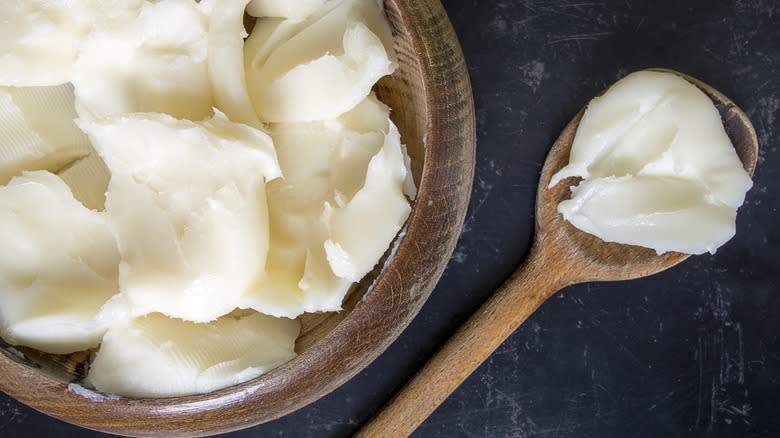The Butter Swap To Consider For Beyond Tender Cake

You're in your kitchen all geared up to bake that delicious pandan chiffon cake you've been dreaming about. Every ingredient is lined up: the eggs, sugar, milk, flour, baking powder, and even the pandan extract, each waiting for its turn. But as you confidently open the fridge, your heart sinks — you've run out of unsalted butter! The very foundation of your culinary dream seems ready to crack like dry cake.
But no need to rush out to the supermarket — if there's a can of vegetable shortening in your pantry, you can swap it in for butter to make that beyond-tender cake you've been dreaming of all day. Why? Shortening, like butter, is basically any fat that remains solid at room temperature, and it's similar enough to serve as a substitute in a pinch. It's made from hydrogenated oil, and these days in the U.S., we closely associate shortening with hydrogenated vegetable oil and the brand Crisco.
Shortening can be used as the foundational fat for your cakes, cookies, tarts, pies, and bread. You can usually find shortening in the baking aisles of your local supermarkets — unrefrigerated, unlike butter. Also unlike butter, shortening tastes like vegetable oil, or the oil that was hydrogenated to create it; unfortunately, that means it won't really taste rich and buttery. But like butter, shortening will make your pie crusts flaky, your shortbread and cookies melty, and your cakes as soft and tender as you could hope, so don't shy away from making use of it.
Read more: 12 Popular Grocery Store Butter Brands, Ranked
Shortening May Not Taste Like Butter But Will Make Your Cakes Fluffy

How exactly does shortening make cakes so light and soft? The explanation rests with food science. Butter, often a baker's best friend, contains approximately 80% dairy butterfat and nearly 20% water. Meanwhile, shortening is 100% fat in the form of hydrogenated vegetable oil and devoid of any water, which has several advantages when baking. Water doesn't trap air like fat does, so cakes baked with butter are often not as voluminous as cakes baked with shortening. Due to shortening's higher melting point, it also stays solid for longer as it bakes, and thus traps more air. These attributes allow for a cake that rises more, holds its elegant shape during the baking process, and most importantly, rewards you with an interior structure that's soft, light, and tender.
So if you're ever caught in a baking conundrum without butter, fret not. While the two ingredients offer slightly different flavor profiles, consider using shortening as a direct swap for butter. While the buttery taste will not be as strong, your bakes, especially cakes, will have great texture and volume as a trade-off.
Read the original article on Tasting Table.


